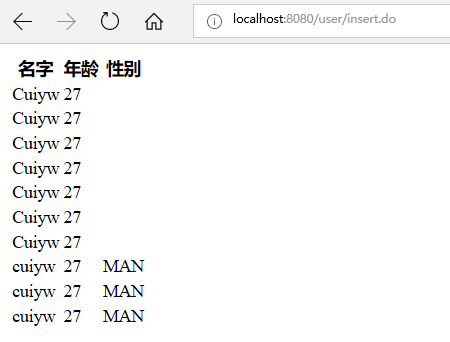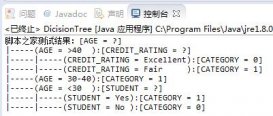前言
今天學習下springboot集成mybatis,集成mybatis一般有兩種方式,一個是基于注解的一個是基于xml配置的。今天先了解下基于注解的mybatis集成。下面話不多說了,來一起看看詳細的介紹吧
一、引入依賴項
因為是mybatis嘛,肯定是要有mybatis相關的,同時用的是mysql,所以也需要引入mysql相關的。
|
1
2
3
4
5
6
7
8
9
10
11
12
|
<!-- https://mvnrepository.com/artifact/org.mybatis.spring.boot/mybatis-spring-boot-starter --> <dependency> <groupid>org.mybatis.spring.boot</groupid> <artifactid>mybatis-spring-boot-starter</artifactid> <version>1.3.2</version> </dependency> <!-- https://mvnrepository.com/artifact/mysql/mysql-connector-java --> <dependency> <groupid>mysql</groupid> <artifactid>mysql-connector-java</artifactid> <version>8.0.11</version> </dependency> |
二、創建model
這里創建了一個user的model,這樣方便與數據庫的表對照,這里在mysql中創建了一個名為mybatis的數據庫,里面創建了一個user的表.同時創建了枚舉類usersexenum.
|
1
2
3
4
5
6
7
|
create table `user` ( `id` int(11) not null auto_increment, `name` varchar(20) default null, `age` int(11) default null, `sex` varchar(20) default null, primary key (`id`)) engine=innodb auto_increment=9 default charset=utf8; |
|
1
2
3
4
5
6
7
8
9
10
11
12
13
14
15
16
17
18
19
20
21
22
23
24
25
26
27
28
29
30
31
32
33
34
35
36
37
38
39
40
41
42
43
|
package com.example.model;import java.io.serializable;public class user implements serializable{ @override public string tostring() { // todo auto-generated method stub return "user [id=" + id + ", name=" + name + ", age=" + age + "]"; } public int getid() { return id; } public void setid(int id) { id = id; } public string getname() { return name; } public void setname(string name) { name = name; } public int getage() { return age; } public void setage(int age) { age = age; } private int id; private string name; private int age; private usersexenum sex; public usersexenum getsex() { return sex; } public void setsex(usersexenum sex) { sex = sex; }} |
|
1
2
3
4
5
|
package com.example.model;public enum usersexenum { man, woman} |
三、創建mapper
這里需要把model與操作數據庫的sql對照起來,用什么對照呢?那就需要創建一個mapper.這里有增刪改查。
|
1
2
3
4
5
6
7
8
9
10
11
12
13
14
15
16
17
18
19
20
21
22
23
24
25
26
27
28
29
30
31
32
33
34
|
package com.example.mapper;import java.util.list;import org.apache.ibatis.annotations.delete;import org.apache.ibatis.annotations.insert;import org.apache.ibatis.annotations.result;import org.apache.ibatis.annotations.results;import org.apache.ibatis.annotations.select;import org.apache.ibatis.annotations.update;import com.example.model.*;;public interface usermapper { @select("select * from user") @results({ @result(property = "sex", column = "sex", javatype = usersexenum.class), @result(property = "name", column = "name") }) list<user> getall(); @select("select * from user where id = #{id}") @results({ @result(property = "sex", column = "sex", javatype = usersexenum.class), @result(property = "name", column = "name") }) user getone(int id); @insert("insert into user(name,age,sex) values(#{name}, #{age}, #{sex})") void insert(user user); @update("update user set name=#{username},age=#{age} where id =#{id}") void update(user user); @delete("delete from user where id =#{id}") void delete(int id);} |
四、配置掃描
上面配置了mapper,那怎么讓系統知道mapper放在哪里呢?于是有了@mapperscan注解。
|
1
2
3
4
5
6
7
8
9
10
11
12
13
14
|
package com.example.demo;import org.mybatis.spring.annotation.mapperscan;import org.springframework.boot.springapplication;import org.springframework.boot.autoconfigure.springbootapplication;@springbootapplication@mapperscan("com.example.mapper")public class demoapplication { public static void main(string[] args) { springapplication.run(demoapplication.class, args); }} |
五、創建controller
這里創建了usercontroller,一個是顯示所有用戶,一個是新增一個用戶之后再顯示所有用戶。
|
1
2
3
4
5
6
7
8
9
10
11
12
13
14
15
16
17
18
19
20
21
22
23
24
25
26
27
28
29
30
31
32
33
34
35
36
37
38
39
40
|
package com.example.demo;import java.util.list;import org.springframework.beans.factory.annotation.autowired;import org.springframework.stereotype.controller;import org.springframework.ui.model;import org.springframework.web.bind.annotation.requestmapping;import org.springframework.web.bind.annotation.requestmethod;import com.example.mapper.usermapper;import com.example.model.user;import com.example.model.usersexenum;@controller@requestmapping("/user")public class usercontroller { @autowired private usermapper usermapper; @requestmapping(value = "/alluser.do",method = requestmethod.get) public string getallusers(model model) { list<user> users=usermapper.getall(); model.addattribute("users", users); return "userlist"; } @requestmapping(value = "/insert.do",method = requestmethod.get) public string adduser(model model) { user user=new user(); user.setname("cuiyw"); user.setage(27); user.setsex(usersexenum.man); usermapper.insert(user); list<user> users=usermapper.getall(); model.addattribute("users", users); return "userlist"; }} |
六、數據庫配置
上面mapper也設置了,model也設置了,那要與數據庫交互,肯定要配置數據庫地址這些信息吧。這里在運行的時候還報了一個錯誤.nested exception is java.sql.sqlexception: the server time zone value 'öð¹ú±ê׼걼ä' is unrecognized or represents more than one time zone. you must configure either the server or jdbc driver (via the servertimezone configuration property) to use a more specifc time zone value if you want to utilize time zone support.在mysql中設置了下時區:set global time_zone='+8:00';
|
1
2
3
4
5
6
7
8
9
|
spring.mvc.view.prefix=/view/spring.mvc.view.suffix=.jspmybatis.type-aliases-package=com.example.modelspring.datasource.driverclassname = com.mysql.cj.jdbc.driverspring.datasource.url = jdbc:mysql://localhost:3306/mybatisspring.datasource.username = rootspring.datasource.password = 123456 |
七、創建頁面顯示
這里還是按照上一博客用jsp顯示數據。
|
1
2
3
4
5
6
7
8
9
10
11
12
13
14
15
16
17
18
|
<%@ page language="java" contenttype="text/html; charset=utf-8" pageencoding="utf-8"%><%@ taglib prefix="c" uri="http://java.sun.com/jsp/jstl/core" %><!doctype html public "-//w3c//dtd html 4.01 transitional//en" "http://www.w3.org/tr/html4/loose.dtd"><html><head><meta http-equiv="content-type" content="text/html; charset=utf-8"><title>insert title here</title></head><body> <table> <tr><th>名字</th><th>年齡</th><th>性別</th></tr> <c:foreach items="${users}" var="item"> <tr><td>${item.name}</td><td>${item.age}</td><td>${item.sex}</td></tr> </c:foreach> </table></body></html> |
八、測試
這里先在瀏覽器打開http://localhost:8080/user/alluser.do,可以看到用戶列表,然后輸入http://localhost:8080/user/insert.do,就會看到列表顯示多了一行數據。

九、小結
使用基于注解的集成mybatis比較省事方便,但有利有弊,對于多表相連的可能就不太方便,使用基于xml配置的可能就更會好些。
好了,以上就是這篇文章的全部內容了,希望本文的內容對大家的學習或者工作具有一定的參考學習價值,如果有疑問大家可以留言交流,謝謝大家對服務器之家的支持。
原文鏈接:https://www.cnblogs.com/5ishare/p/9292201.html














